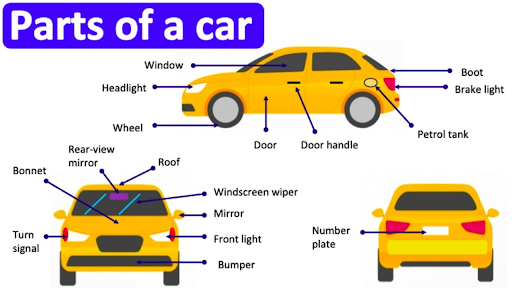While learning how to drive, I was also improving my Chinese.
My mother would sit next to me and tell me in Chinese what to do or what I did wrong. I was able to pick up new vocab and apply them in my fluency exams.
Here are some words that you will encounter in your driving lessons or to use in exams.
Parts of the Car
Steering wheel: 方向盘 (fāng xiàng pán)
This literally means "direction (方向) plate (盘)."
Rearview mirror: 后视镜 (hòu shì jìng)
To say “side mirror” add 外 (wài, outside) to make 外后视镜. Think “outside rearview mirror” to help you remember.
Gear stick: 排档杆 (pái dàng gān)
Gas pedal: 油门 (yóu mén)
Brake pedal: 刹车 (shā chē)
This word literally means "kill the car."
Directions and Tasks
Start the car: 启动汽车 (qǐ dòng qì chē)
Shift gears: 换挡 (huàn dǎng)
Turn on the turn signal: 打转向灯 (dǎ zhuàn xiàng dēng)
Turn left/right: 往左/右转 (wǎng zuǒ/yòu zhuǎn)
Pull over: 停在路边 (tíng zài lù biān)
Park: 停车 (tíngchē)
To say “parallel parking” add 平行(píngxíng, parallel) to make 平行停车.
U-turn: U 型转弯 (U xíng zhuǎnwān) or 掉头 (diàotóu)
掉头 means "to turn your head."
Miscellaneous
Intersection: 路口 (lùkǒu)
路口 is literally "road mouth."
Stop sign: 停车标志 (tíngchē biāozhì)
Traffic light: 红绿灯 (hónglǜdēng)
This literally translates to "red green light."
Crosswalk: 人行横道 (rénxínghéngdào)
Pedestrians: 行人 (xíngrén)
One way street: 单行道 (dānxíng dào)
Blind spot: 盲点 (mángdiǎn)
Let’s see this vocab in action. Below is an example dialogue between a driving instructor and a student.
Instructor: 一上车我们应该首先做什么?
(Yī shàng chē wǒmen yīnggāi shǒuxiān zuò shénme?)
What should we do first when we get in the car?
Student: 系安全带,调座椅、后视镜,然后启动汽车。
(Xì ānquán dài, diào zuò yǐ, hòu shì jìng, ránhòu qǐdòng qìchē.)
Fasten the seat belt, adjust the seat and mirrors, and then start the car.
I: 对,你知道换挡前先要做什么吗?
(Duì, nǐ zhīdào huàn dǎng qián xiān yào zuò shénme ma?)
Yes, do you know what you first must do before changing gears?
S: 要首先踩下刹车同时才可以使用排挡杆来换挡。
(Yào shǒuxiān cǎi xià shāchē tóngshí cái kěyǐ shǐyòng páidǎng gān lái huàn dǎng.)
You must first press the brake pedal in order to use the gearshift to change gears.
I: 对,那我们出行吧!记得打转向灯,砖头看盲点,预转方向盘,慢慢踩下油门。到红绿灯往右转,然后一直直行。
(Duì, nà wǒmen chūxíng ba! Jìdé dǎ zhuàn xiàng dēng, zhuāntóu kàn mángdiǎn, yù zhuǎn fāngxiàngpán, màn man cǎi xià yóumén. Dào hónglǜdēng wǎng yòu zhuǎn, ránhòu yīzhí zhíxíng.)
Yes, let’s head out. Remember to use the turn signal, look at your blind spot, pre-turn the wheel, and slowly accelerate. Turn right at the traffic light and keep straight.)
S: 好的。
(Hǎo de)
OK
I: 在前面你会遇到一个停车标志,在人行横道或停线后面停。为行人让路!
(Zài qiánmiàn nǐ huì yù dào yīgè tíngchē biāozhì, zài rénxínghéngdào huò tíng xiàn hòumiàn tíng. Wèi xíngrén rànglù!)
In front you will encounter a stop sign, stop behind the crosswalk or stop line. Make way for pedestrians!






0 Comments